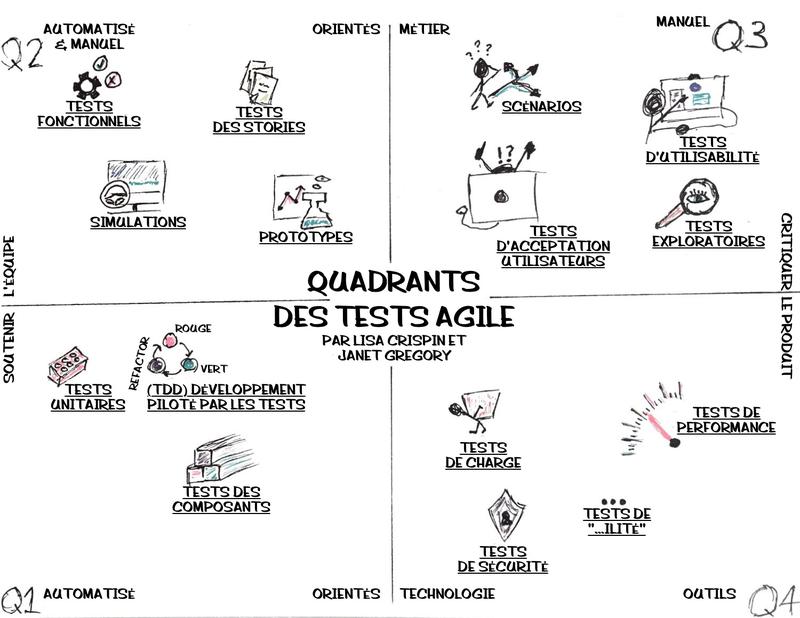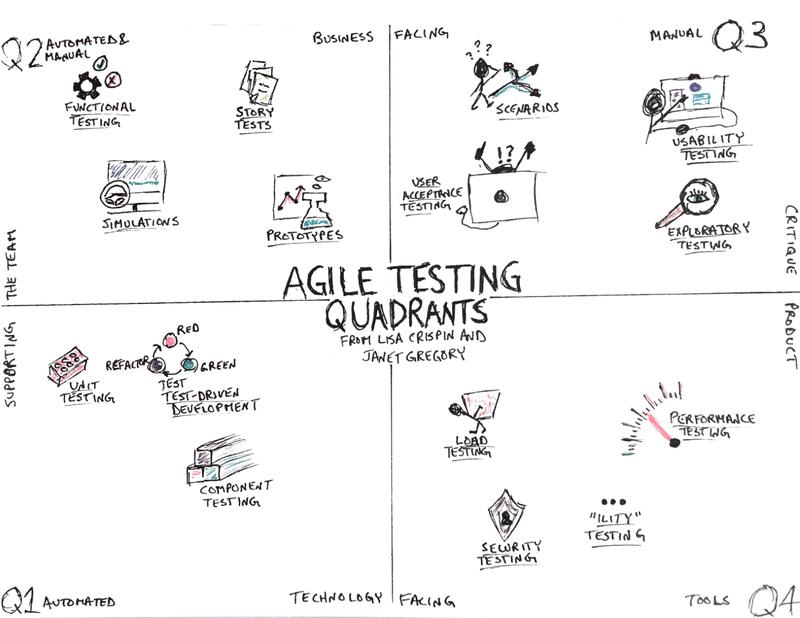« Quadrants des tests Agile » : différence entre les versions
Aucun résumé des modifications |
Aucun résumé des modifications |
||
| Ligne 4 : | Ligne 4 : | ||
---- | ---- | ||
''Traduction :''<br /> <br /> [[Image:AgileTestingQuadrantsSketchnote_fr.jpg|AgileTestingQuadrantsSketchnote_fr.jpg]]<br /> | ''Traduction :''<br /> <br /> [[Image:AgileTestingQuadrantsSketchnote_fr.jpg|AgileTestingQuadrantsSketchnote_fr.jpg]]<br /> | ||
Les quadrants de tests Agile séparent le propcessus global en quatre Quadrants et permet de comprendre la façon dont les tests Agile sont exécutés.<br /> | |||
<br/> | |||
'''Quadrant Agile I''' – Dans ce quadrant, on se concentre sur la qualité interne du code, avec des cas de tests pilotés par la technologie et mis en oeuvre pour aider l'équipe. On y trouve : <br/> | |||
# Tests unitaires | |||
# Tests de componsants | |||
<br/> | |||
'''Quadrant Agile II''' – It contains test cases that are business driven and are implemented to support the team. This Quadrant focuses on the requirements. The kind of test performed in this phase is | |||
1. Testing of examples of possible scenarios and workflows | |||
2. Testing of User experience such as prototypes | |||
3. Pair testing | |||
<br/> | |||
'''Quadrant Agile III''' – This quadrant provide feedback to quadrants one and two. The test cases can be used as the basis to perform automation testing. In this quadrant, many rounds of iteration reviews are carried out which builds confidence in the product. The kind of testing done in this quadrant is | |||
1. Usability Testing | |||
2. Exploratory Testing | |||
3. Pair testing with customers | |||
4. Collaborative testing | |||
5. User acceptance testing | |||
<br/> | |||
'''Quadrant Agile IV''' – This quadrant concentrates on the non-functional requirements such as performance, security, stability, etc. With the help of this quadrant, the application is made to deliver the non-functional qualities and expected value. | |||
1. Non-functional tests such as stress and performance testing | |||
2. Security testing with respect to authentication and hacking | |||
3. Infrastructure testing | |||
4. Data migration testing | |||
5. Scalability testing | |||
6. Load testing | |||
---- | ---- | ||
[[Image:AgileTestingQuadrantsSketchnote_en.jpg|AgileTestingQuadrantsSketchnote_en.jpg]] | [[Image:AgileTestingQuadrantsSketchnote_en.jpg|AgileTestingQuadrantsSketchnote_en.jpg]] | ||
Version du 6 juillet 2018 à 12:16
Date : 23/07/2017
Traduction :

Les quadrants de tests Agile séparent le propcessus global en quatre Quadrants et permet de comprendre la façon dont les tests Agile sont exécutés.
Quadrant Agile I – Dans ce quadrant, on se concentre sur la qualité interne du code, avec des cas de tests pilotés par la technologie et mis en oeuvre pour aider l'équipe. On y trouve :
- Tests unitaires
- Tests de componsants
Quadrant Agile II – It contains test cases that are business driven and are implemented to support the team. This Quadrant focuses on the requirements. The kind of test performed in this phase is
1. Testing of examples of possible scenarios and workflows
2. Testing of User experience such as prototypes
3. Pair testing
Quadrant Agile III – This quadrant provide feedback to quadrants one and two. The test cases can be used as the basis to perform automation testing. In this quadrant, many rounds of iteration reviews are carried out which builds confidence in the product. The kind of testing done in this quadrant is
1. Usability Testing
2. Exploratory Testing
3. Pair testing with customers
4. Collaborative testing
5. User acceptance testing
Quadrant Agile IV – This quadrant concentrates on the non-functional requirements such as performance, security, stability, etc. With the help of this quadrant, the application is made to deliver the non-functional qualities and expected value.
1. Non-functional tests such as stress and performance testing
2. Security testing with respect to authentication and hacking
3. Infrastructure testing
4. Data migration testing
5. Scalability testing
6. Load testing
